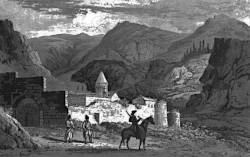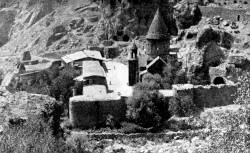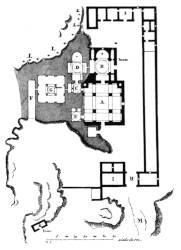Գեղարդավանք
Geghard Monastery - Gegharda-dzor - Ayrivank
Useful Information

| Location: |
Mets Gilanlar.
Northeast of Garni, at the end of the gorge of the Azat river. (40.139935, 44.818476) |
| Open: |
All year daily 9-18. [2023] |
| Fee: |
Monastery free, Parking AMD 200. [2023] |
| Classification: |
 Cave Churche Cave Churche
|
| Light: |
 Incandescent Electric Light System Incandescent Electric Light System
|
| Dimension: | |
| Guided tours: | self guided |
| Photography: | allowed, no flash |
| Accessibility: | no |
| Bibliography: |
O. Khalpakhchian (1980):
Architectural Ensembles of Armenia,
Moscow, Iskusstvo Publishers.

|
| Address: | Geghard Monastery, Mets Gilanlar, Tel: +374 95 371367. |
| As far as we know this information was accurate when it was published (see years in brackets), but may have changed since then. Please check rates and details directly with the companies in question if you need more recent info. |
|
History
| 4th century | founded by St. Gregory the Illuminator, according to legend. |
| 9th century | destroyed and burned down by Arabs. |
| 10-13th century | first buildings erected. |
| 1215 | main church constructed with the support of the brothers Zakare and Ivane who were generals of Queen Tamar of Georgia. |
| 1283 | Avazan church carved into the rock. |
| 2000 | inscribed on the UNESCO World Heritage List. |
Description


Գեղարդավանք (Geghard Monastery) was originally known as Այրիվանք (Ayrivank, Monastery of the Cave), as most of the monastery is carved out of the rock. According to legend it was founded by St. Gregory the Illuminator. At beginning of the 4th century Christianity was adopted as a state religion in Armenia and at that time the first caves were built. However, the Arabs tried to conquer the area for centuries and in the 9th century they burned down the monastery, which obviously destroyed the surface buildings, but did little harm to the caves.
In the 13th century it was renamed Գեղարդ (Geghard, Spear) or Գեղարդավանք (Geghardavank) which means Monastery of the Spear in Armenian. This name is a regard to the most important relic of the monastery, a 2000 years old roman lance, which is said to be the one used to test if Jesus Christ was dead. It was allegedly brought here by the Apostle Thaddeus, aka Apostle Jude, the brother of Jesus. Others say it was the Roman legionary who nailed Jesus Christ on the cross. However, the Holy Lance was kept in the Monastery for 500 years. Today it is on display in the Alex and Marie Manoogian Treasury House Museum on the grounds of Echmiadzin Cathedral.
During the 13th century the main architectural complex was completed. It consists of the cathedral, the adjacent narthex, eastern and western rock-cut churches, the family tomb of Proshyan princes, and Papak’s and Ruzukan’s tomb-chapel. The monastery was rebuilt with the support of the brothers Zakare and Ivane who were generals of Queen Tamar of Georgia. The cathedral was completed in 1215. Then Armenian Prince Prosh Khaghbakian took over and completed Geghard Monastery as it is today.
The main building of the monastery is Avazan church an ensemble of two subsequent churches, carved into the rock. The first cave church was built in the first half of the 13th century, with an equal-armed cruciform plan. A roughly square chamber on the left side was one of the zhamatoun (princely tombs) of the Proshyan Dynasty. The second cave church was built in the second half of the 13th century, around 1283. A second zhamatoun, with the tombs of the princes Merik and Grigor is reached by an external staircase. At the same time a defensive wall was erected, which encircled the monastery complex. But most of the monks lived in cells excavated into the rock-face outside this wall. Hundreds of khachkars (cross-stones) and caves are built in the rocks surrounding the Monastery.
Also outside the defensive wall on the western side is St. Astvatsatsin chapel (Holy Mother of God). It is partially hewed into the rock and engraved inscriptions on the walls show the dates 1177 and 1181, so this is thought to be the most ancient preserved monument.
The monastery may be visited in a day trip from Yerevan.
- See also
 Subterranean World Heritage List
Subterranean World Heritage List Search DuckDuckGo for "Geghard Monastery"
Search DuckDuckGo for "Geghard Monastery" Google Earth Placemark
Google Earth Placemark Geghard - Wikipedia (visited: 27-MAY-2023)
Geghard - Wikipedia (visited: 27-MAY-2023) Geghardavank monastery (visited: 27-MAY-2023)
Geghardavank monastery (visited: 27-MAY-2023) Geghard Monastery (visited: 27-MAY-2023)
Geghard Monastery (visited: 27-MAY-2023) A Complete Travel Guide to Geghard Monastery (Tips & More!) (visited: 27-MAY-2023)
A Complete Travel Guide to Geghard Monastery (Tips & More!) (visited: 27-MAY-2023) Geghard Monastery - Atlas Obscura (visited: 26-MAY-2023)
Geghard Monastery - Atlas Obscura (visited: 26-MAY-2023) Monastery of Geghard and the Upper Azat Valley - UNESCO World Heritage List (visited: 27-MAY-2023)
Monastery of Geghard and the Upper Azat Valley - UNESCO World Heritage List (visited: 27-MAY-2023)
 Index
Index Topics
Topics Hierarchical
Hierarchical Countries
Countries Maps
Maps